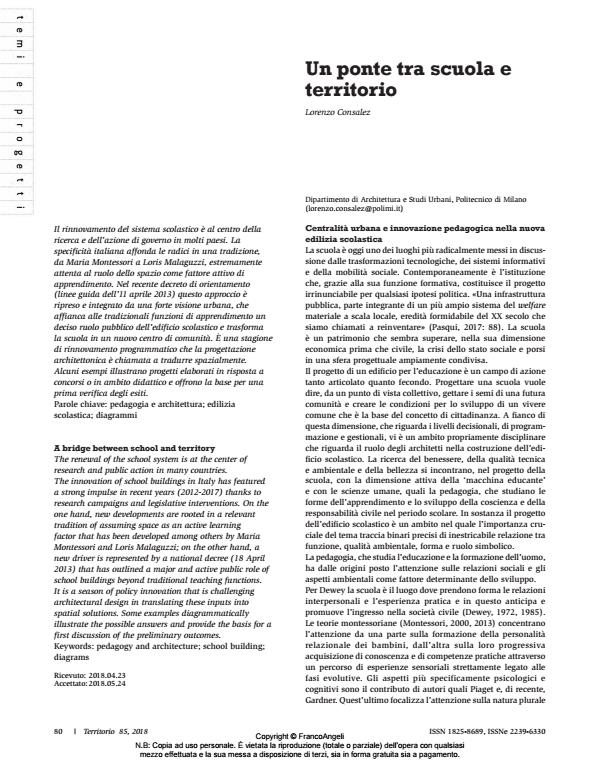A bridge between school and territory
Journal title TERRITORIO
Author/s Lorenzo Consalez
Publishing Year 2018 Issue 2018/85
Language Italian Pages 13 P. 80-92 File size 3899 KB
DOI 10.3280/TR2018-085010
DOI is like a bar code for intellectual property: to have more infomation
click here
Below, you can see the article first page
If you want to buy this article in PDF format, you can do it, following the instructions to buy download credits

FrancoAngeli is member of Publishers International Linking Association, Inc (PILA), a not-for-profit association which run the CrossRef service enabling links to and from online scholarly content.
The renewal of the school system is at the center of research and public action in many countries. The innovation of school buildings in Italy has featured a strong impulse in recent years (2012-2017) thanks to research campaigns and legislative interventions. On the one hand, new developments are rooted in a relevant tradition of assuming space as an active learning factor that has been developed among others by Maria Montessori and Loris Malaguzzi; on the other hand, a new driver is represented by a national decree (18 April 2013) that has outlined a major and active public role of school buildings beyond traditional teaching functions. It is a season of policy innovation that is challenging architectural design in translating these inputs into spatial solutions. Some examples diagrammatically illustrate the possible answers and provide the basis for a first discussion of the preliminary outcomes.
Keywords: Pedagogy and architecture; school building; diagrams
- Cultural Heritage Education in the Everyday Landscape Bertrando Bonfantini, pp.11 (ISBN:978-3-031-10394-0)
- Back to (the Future) School. Reshaping the Relationship Between Mobility and Schools Fabrizia Cannella, Samuel Fattorelli, Maria Chiara Tosi, Valentina Rossella Zucca, in Cahiers de la recherche architecturale, urbaine et paysagère /2022
DOI: 10.4000/craup.11501 - Le scuole tra piani, burocrazie e modelli. Il caso milanese Cristina Renzoni, Paola Savoldi, in TERRITORIO 90/2020 pp.50
DOI: 10.3280/TR2019-090006
Lorenzo Consalez, Un ponte tra scuola e territorio in "TERRITORIO" 85/2018, pp 80-92, DOI: 10.3280/TR2018-085010